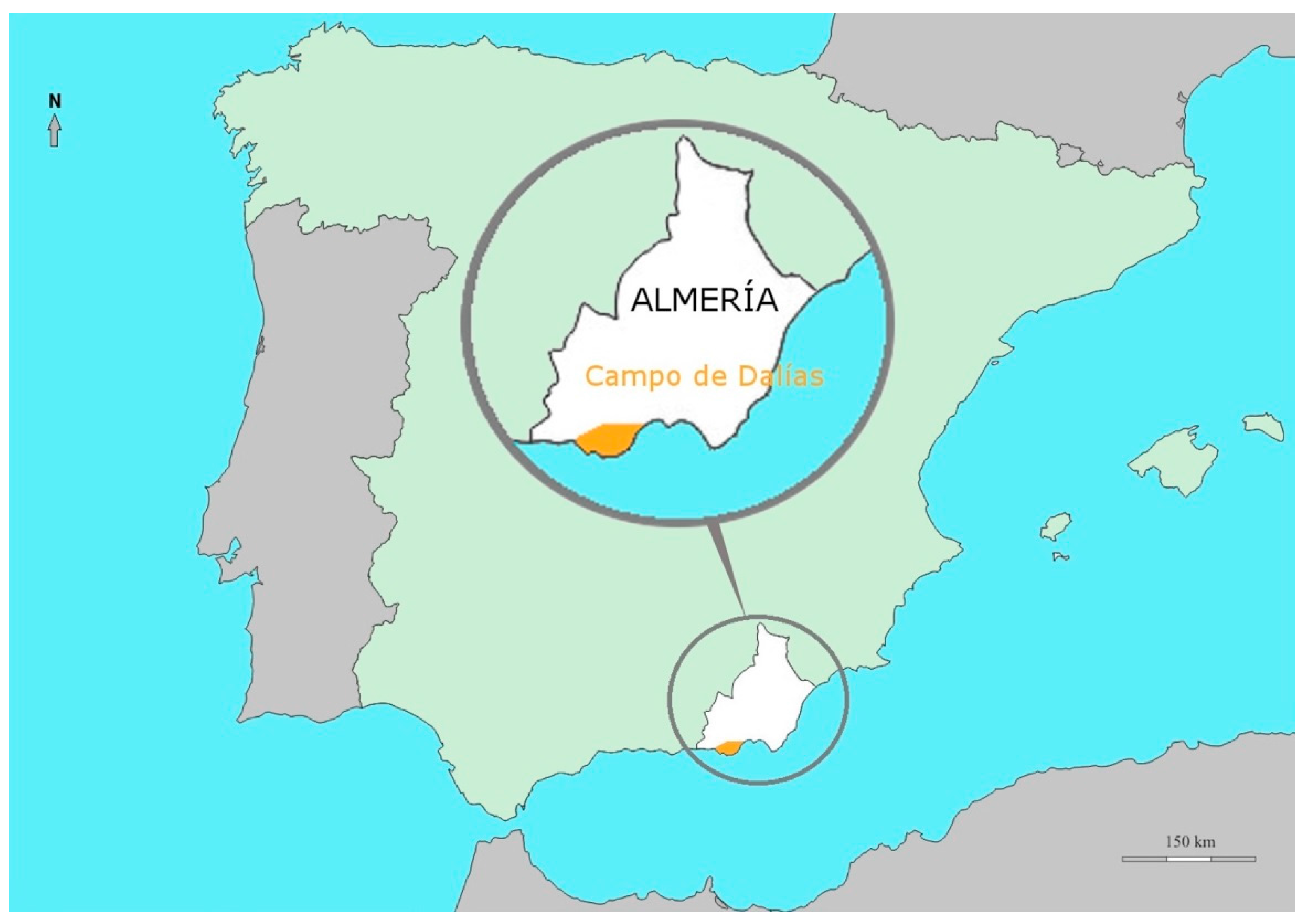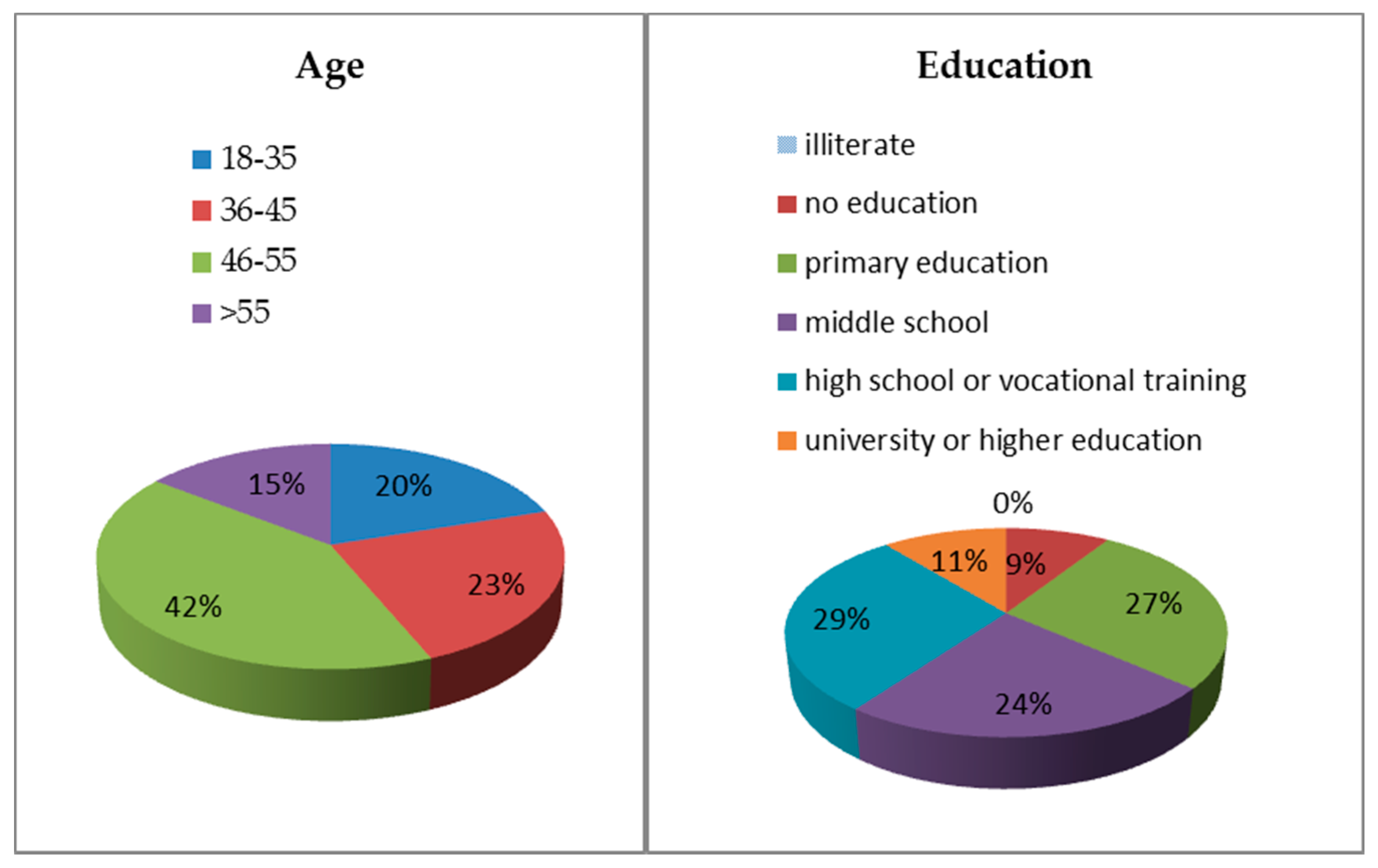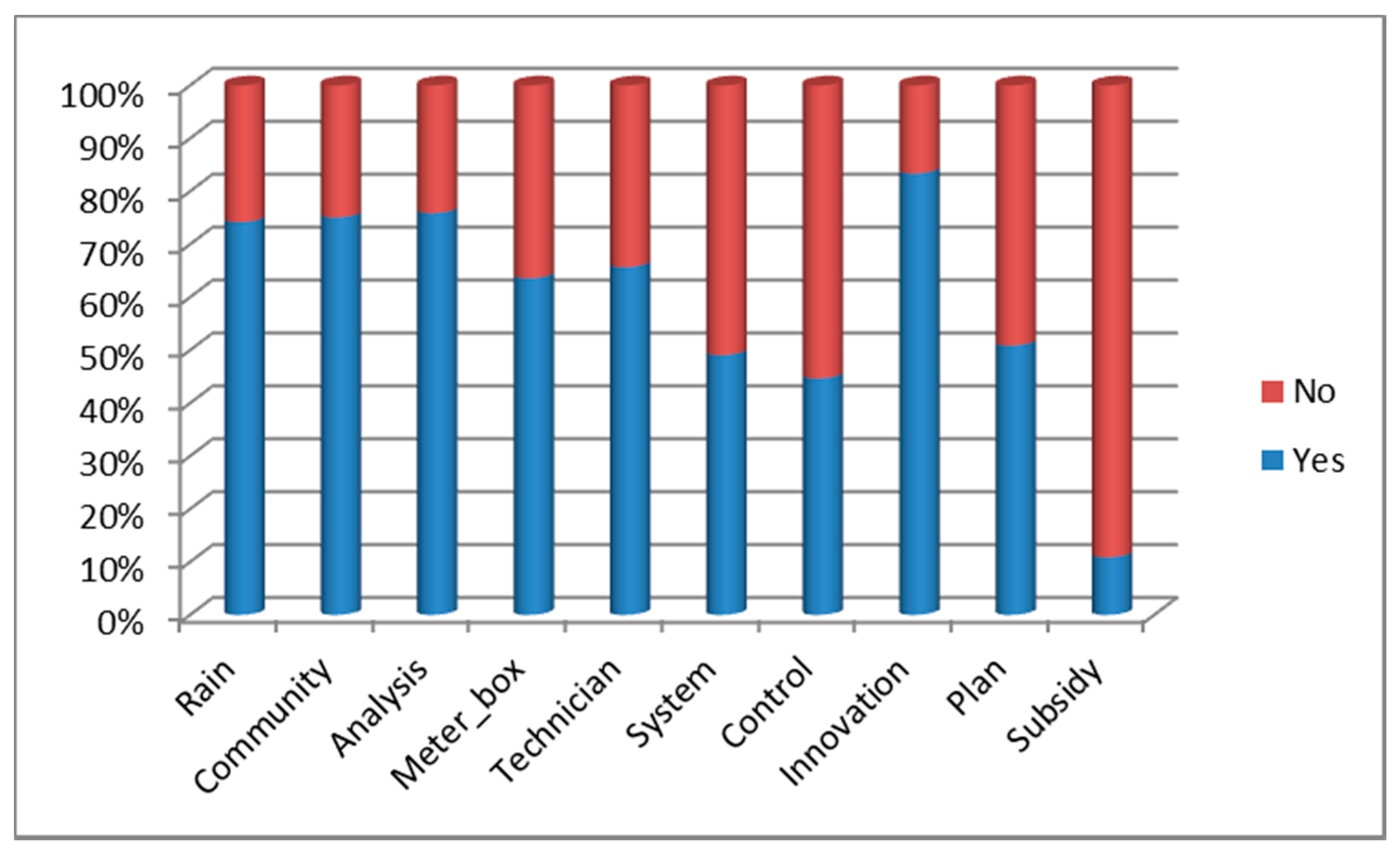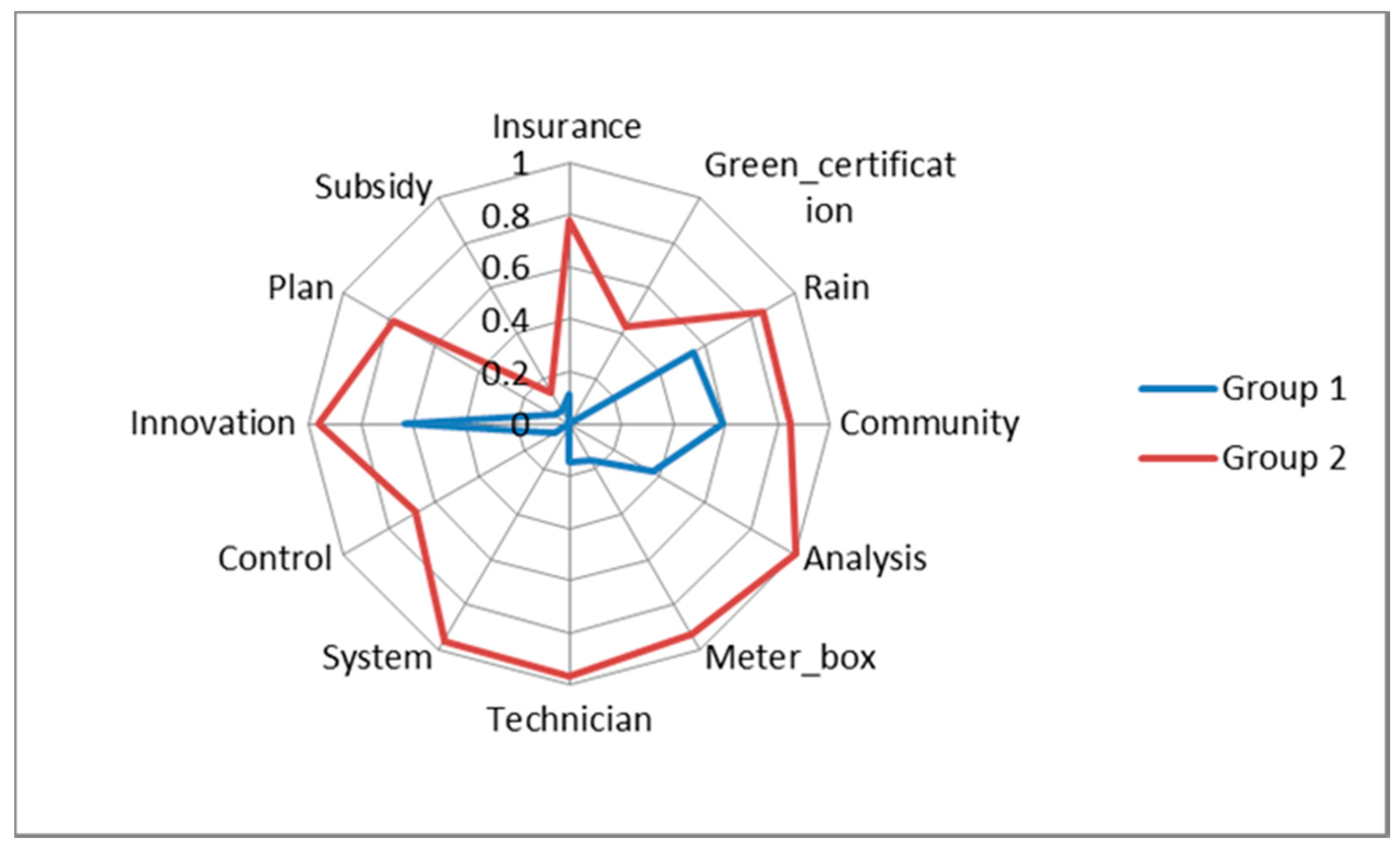How to Improve Water Usage Efficiency? Characterization of Family Farms in A Semi-Arid Area
Abstract
:1. Introduction
2. Research Area
3. Data and Methodology
3.1. Data Collection
3.2. Analysis and Methods
4. Main Results
4.1. Findings from the Descriptive Statistic. Profile of the Respondents
4.2. Findings from the Cluster Analysis. Typology of Family Farms with Regard to Water Usage Efficiency
- Group 1: consisting of the less efficient farms regarding water usage, this group accounts for 38.2% of the farms in the sample (42 observations). Their mean WP of 10.43 €/m3 and WUE of 18.72 kg/m3 are 23% and 17%, respectively, lower than in Group 2. This cluster is therefore identified as having less efficient water usage. Their average water supplied of 5113 m3 per hectare is 16% higher than in the Group 2, with essentially the same yield. 37% of the farms perform water analysis; 55% harvest rainwater; 59% use water from an irrigation community; only 16% have a water meter box; and, 15% use technical advice for irrigation. None use irrigation on demand; 63% of the farms have implemented an innovation for irrigation with only 6% receiving a subsidy; and, 7% have a water usage efficiency plan, although 81% of these farmers claim to carry out water-saving practices in their daily life. The farmers are approximately 48 years old, and their average education level is primary school. The percentage of farm decision-makers that are women is 19.7%. These farms have cultivated about three types of crops in the last years and 11% of the farms have taken out agrarian insurance. 63% of the farmers claim to be environmentally aware, and 59% think the sector is also highly aware. About 73% of the yield from these farms is biological, but none of them have other environmental certifications.
- Group 2: is the larger cluster, including 61.8% of the farms in the sample (68 observations). Their mean WP of 13.54 €/m3 and WUE of 22.60 kg/m3 are 23% and 17%, respectively, higher than in Group 2. This cluster is therefore identified as being more efficient regarding water usage. Their mean water supplied of 4420 m3 per hectare is 16% lower than the other groups, while the average yield is 109.15 tons per hectare. All of the farms perform water analysis; 86% harvest the rainwater; 85% use water from an irrigation community; and, 93% have a water meter box. Almost all of them use technical advice and irrigation on demand, employing tensiometers in 68% of the cases. Only 14% have received a subsidy, but this has not prevented them from implementing water innovations. 78% of them have a water usage efficiency plan, and they carry out water-saving measures in their daily life. The farmers are about 43 years old, and their average education level is high school or vocational training. Approximately 39% of farm decision-makers are women and 78% of them have taken out agrarian insurance. 96% of the farmers claim to be environmentally aware and 82% also consider the sector to be aware. 90% of the yield is biological, and 43% of farms have other environmental certifications, but only 25% of them consider these certifications to be closely related to efficient water usage.
5. Discussion
6. Conclusions
Acknowledgments
Author Contributions
Conflicts of Interest
References
- Azad, M.A.S.; Ancev, T. Measuring environmental efficiency of agricultural water use: A Luenberger environmental indicator. J. Environ. Manag. 2014, 145, 314–320. [Google Scholar] [CrossRef] [PubMed]
- Todorovic, M.; Mehmeti, A.; Scardigno, A. Eco-efficiency of agricultural water systems: Methodological approach and assessment at meso-level scale. J. Environ. Manag. 2016, 165, 62–71. [Google Scholar] [CrossRef] [PubMed]
- Aldaya, M.M.; Garrido, A.; Llamas, M.R.; Varela-Ortega, C.; Novo, P.; Rodríguez Casado, R. Water footprints and virtual trade in Spain. In Water Policy in Spain; Garrido, A., Llamas, M.R., Eds.; CRC Press: Leiden, The Netherlands, 2010; pp. 49–59. [Google Scholar]
- European Union. Directive 2000/60/EC of the European Parliament and of the Council of 23 October 2000 Establishing a Framework for Community Action in the Field of Water Policy; European Union: Brussels, Belgium, 2000. [Google Scholar]
- Sotelo, J.A. Huella Hídrica, Desarrollo y Sostenibilidad en España; Fundación Mapfre: Madrid, Spain, 2011. (In Spanish) [Google Scholar]
- Duarte, R.; Pinilla, V.; Serrano, A. The water footprint of the Spanish agricultural sector: 1860–2010. Ecol. Econ. 2014, 108, 200–207. [Google Scholar] [CrossRef]
- López-Gunn, E.; Zorrilla, P.; Prieto, F.; Llamas, M.R. Lost in translation? Water efficiency in Spanish agriculture. Agric. Water Manag. 2012, 108, 83–95. [Google Scholar] [CrossRef]
- Zoebl, D. Is Water Productivity a Useful Concept in Agricultural Water Management? Agric. Water Manag. 2006, 84, 265–273. [Google Scholar] [CrossRef]
- Galdeano-Gómez, E.; Pérez-Mesa, J.C.; Godoy-Durán, A. The social dimension as a driver of sustainable development: The case of family farms in southeast Spain. Sustain. Sci. 2016, 11, 349–362. [Google Scholar] [CrossRef]
- Fernández, M.D.; González, A.M.; Carreño, J.; Pérez, C.; Bonachela, S. Analysis of on-farm irrigation performance in Mediterranean greenhouses. Agric. Water Manag. 2007, 89, 251–260. [Google Scholar]
- Cajamar. Análisis de la Campaña Hortofrutícola de Almería, Campaña 2014/2015; Cajamar: Almería, Spain, 2016. (In Spanish) [Google Scholar]
- Cazcarro, I.; Duarte, R.; Martin-Retortillo, M.; Pinilla, V.; Serrano, A. How sustainable is the increase in the water footprint of the Spanish agricultural sector? A provincial analysis between 1955 and 2005–2010. Sustainability 2015, 7, 5094–5119. [Google Scholar] [CrossRef]
- Ma, H.; Shi, C.; Chou, N. China’s Water Utilization Efficiency: An Analysis with Environmental Considerations. Sustainability 2016, 8, 516. [Google Scholar] [CrossRef]
- Mitchell, M.; Curtis, A.; Sharp, E.; Mendham, E. Social Research to Improve Groundwater Governance: A Literature Review; Institute for Land, Water and Society, Charles Sturt University: Albury, Australia, 2011. [Google Scholar]
- Frija, A.; Chebil, A.; Speelman, S. Farmers’ adaptation to groundwater shortage in the dry areas: Improving appropriation or enhancing accommodation? Irrig. Drain. 2016, 65, 691–700. [Google Scholar] [CrossRef]
- Wheeler, S.; Zuo, A.; Bjornlund, H. Farmers’ climate change beliefs and adaptation strategies for a water scarce future in Australia. Glob. Environ. Chang. 2013, 23, 537–547. [Google Scholar] [CrossRef]
- Barr, N. The House on the Hill: The Transformation of Australia’s Farming Communities; Land & Water Australia and Halstead Press: Canberra, Australia, 2009. [Google Scholar]
- Van Steenbergen, F.; Kaisarani, A.B.; Khan, N.U.; Gohar, M.S. A case of groundwater depletion in Balochistan, Pakistan: Enter into the void. J. Hydrol. Reg. Stud. 2015, 27, 36–47. [Google Scholar] [CrossRef]
- Piedra-Muñoz, L.; Vega-López, L.L.; Galdeano-Gómez, E.; Zepeda-Zepeda, J.A. Drivers for efficient water use in agriculture: An empirical analysis of family farms in Almería (Spain). Exp. Agric. 2016. [Google Scholar] [CrossRef]
- Gómez-Limón, J.A.; Arriaza, M.; Villanueva, A.J. Typifying irrigated areas to support policy design and implementation: The case of the Guadalquivir river basin. Irrig. Drain. 2013, 62, 322–329. [Google Scholar] [CrossRef]
- Gleick, P.H.; Christina-Smith, J.; Cooley, H. Water-use efficiency and productivity: Rethinking the basin approach. Water Int. 2011, 36, 784–798. [Google Scholar] [CrossRef]
- Lu, Y.; Zhang, X.; Chen, S.; Shao, L.; Sun, H. Changes in water use efficiency and water footprint in grain production over the past 35 years: A case study in the North China Plain. J. Clean. Prod. 2016, 116, 71–79. [Google Scholar] [CrossRef]
- Guo, S.; Shen, G.Q.; Peng, Y. Embodied agricultural water use in China from 1997 to 2010. J. Clean. Prod. 2016, 112, 3176–3184. [Google Scholar] [CrossRef]
- González, A.M. Programas de Riego Para Cultivos Hortícolas en Invernaderos Enarenados en Almería. Ph.D. Thesis, University of Almería, Almería, Spain, 2003. (In Spanish). [Google Scholar]
- Bonachela, S.; González, A.M.; Fernández, M.D. Irrigation scheduling of plastic greenhouse vegetable crops based on historical weather data. Irrig. Sci. 2006, 25, 53–62. [Google Scholar] [CrossRef]
- Junta, D.A. Caracterización de los Invernaderos de Andalucía; Junta de Andalucía: Seville, Spain, 2015. (In Spanish) [Google Scholar]
- Junta, D.A. Cartografía de Invernaderos en el Litoral de Andalucía Oriental; Junta de Andalucía: Seville, Spain, 2016. (In Spanish) [Google Scholar]
- García García, M.C.; Céspedes López, A.J.; Pérez Parra, J.J.; Lorenzo Mínguez, P. El Sistema de Producción Hortícola Protegido de la Provincia de Almería; IFAPA: Seville, Spain, 2016. (In Spanish) [Google Scholar]
- Valera, D.; Belmonte, L.; Molina, F.; López, A. Greenhouse Agriculture in Almería. A Comprehensive Techno-Economic Analysis; Cajamar: Almería, Spain, 2016. [Google Scholar]
- Galdeano-Gómez, E.; Aznar-Sánchez, J.A.; Pérez-Mesa, J.C. Sustainability dimensions related to agricultural based-development: The experience of 50 years of intensive farming in Almería (Spain). Int. J. Agric. Sustain. 2013, 11, 125–143. [Google Scholar] [CrossRef]
- Piedra-Muñoz, L.; Galdeano-Gómez, E.; Pérez-Mesa, J.C. Is sustainability compatible with profitability? An empirical analysis on family farms activity. Sustainability 2016, 8, 893. [Google Scholar] [CrossRef]
- Sun, S.; Liu, J.; Wu, P.; Wang, Y.; Zhao, X.; Zhang, X. Comprehensive evaluation of water use in agricultural production: A case study in Hetao Irrigation District, China. J. Clean. Prod. 2016, 112, 4569–4575. [Google Scholar] [CrossRef]
- Levidow, L.; Zaccaria, D.; Maria, R.; Vivas, E.; Todorovic, M. Improving water-efficient irrigation: Prospects and difficulties of innovative practices. Agric. Water Manag. 2014, 146, 84–94. [Google Scholar] [CrossRef]
- López-Gunn, E.; Mayor, B.; Dumont, A. Implications of the modernization of irrigation systems. In Water, Agriculture and the Environment in Spain: Can We Square the Circle? De-Stefano, L., Ed.; CRC Press/Balkema: Leiden, The Netherlands, 2012; pp. 241–253. [Google Scholar]
- Wang, J.; Xu, Z.; Huang, J.; Rozelle, S. Incentives to managers or participation of farmers in China’s irrigation systems: Which matters most for water savings, farmer income, and poverty? Agric. Econ. 2006, 34, 315–330. [Google Scholar] [CrossRef]
- Setyaningsih, S. Using cluster analysis study to examine the successful performance entrepreneur in Indonesia. Procedia Econ. Financ. 2012, 4, 286–298. [Google Scholar] [CrossRef]
- Hair, J.F.; Black, C.W.; Babin, J.B.; Anderson, E.R.; Tatham, L.R. Multivariate Data Analysis; Pearson Prentice Hall: Upper Saddle River, NJ, USA, 2006. [Google Scholar]
- Kobrich, C.; Rehman, T.; Khan, M. Typification of farming systems for constructing representative farm models: Two illustrations of the application of multi-variate analyses in Chile and Pakistan. Agric. Syst. 2003, 76, 141–157. [Google Scholar] [CrossRef]
- Jung, Y.; Park, H.; Du, D.; Drake, B.L. A decision criterion for the optimal number of clusters in hierarchical clustering. J. Glob. Optim. 2003, 25, 91–111. [Google Scholar] [CrossRef]
- Kuswardhani, N.; Soni, P.; Shivakoti, G.P. Cluster analysis for classification of farm households based on socio-economic characteristics for technology adoption in agriculture: A case study of West Java province, Indonesia. J. Food Agric. Environ. 2014, 12, 238–247. [Google Scholar]
- Nunes, B.; Bennett, D.; Marques Júnior, S. Sustainable agricultural production: An investigation in Brazilian semi-arid livestock farms. J. Clean. Prod. 2014, 64, 414–425. [Google Scholar] [CrossRef]
- Maleksaeidi, H.; Karami, E.; Zamani, G.H.; Rezaei-Moghaddam, K.; Hayati, D. Discovering and characterizing farm households´resilience under water scarcity. Environment, Development and Sustainability 2016, 18, 499–525. [Google Scholar] [CrossRef]
- Gil, M.; Garrido, A.; Gómez-Ramos, A. Análisis de la productividad de la tierra y del agua en el regadío español. In La Economía del Agua de Riego en España; Gómez-Limón, J.A., Calatrava, J., Garrido, A., Sáez, F.J., Eds.; Fundación Cajamar: Almería, Spain, 2009; pp. 95–114. (In Spanish) [Google Scholar]
- Nguyen, T.P.L.; Mula, L.; Cortignani, R.; Seddaiu, G.; Dono, G.; Virdis, S.G.P.; Pasqui, M.; Roggero, P.P. Perceptions of present and future climate change impacts on water availability for agricultural systems in the Western Mediterranean Region. Water 2016, 8, 523. [Google Scholar] [CrossRef]
- Ervin, C.A.; Ervin, D.E. Factor affecting the use of soil conservation practices: Hypotheses, evidence and policy implications. Land. Econ. 1982, 58, 277–292. [Google Scholar] [CrossRef]
- Karali, E.; Brunner, B.; Doherty, R.; Hersperger, A.; Rounsevell, M. Identifying the factors that influence farmer participation in environmental management practices in Switzerland. Hum. Ecol. 2014, 42, 951–963. [Google Scholar] [CrossRef]
- Tong, Y.; Fan, L.; Niu, H. Water conservation awareness and practices in households receiving improved water supply: A gender-based analysis. J. Clean. Prod. 2017, 141, 947–955. [Google Scholar] [CrossRef]
- Galdeano-Gómez, E.; Zepeda-Zepeda, J.A.; Piedra-Muñoz, L.; Vega-López, L.L. Family farm´s features influencing socio-economic sustainability: An analysis of agrifood sector in southeast Spain. New Medit 2017, 1, 50–61. [Google Scholar]
- Jorgensen, B.; Graymore, M.; O’Toole, K. Household water use behavior: An integrated model. J. Environ. Manag. 2009, 91, 227–236. [Google Scholar] [CrossRef] [PubMed]





| Name of Variable | Description |
|---|---|
| Personal Attributes of the Farmer | |
| Age | Farmer’s age |
| Education | Farmer’s education, measured on a scale of 0—no education to 5—university or higher education |
| Characteristics of the Farm | |
| Women | Percentage of farm decision-makers that are women |
| Scale | Area of agricultural farm in hectares |
| Generation | Farm’s age, measured by the number of generations that have run the family farm |
| Employment | Number of total workers per hectare |
| Yield | Annual crop production in tons per hectare |
| Income | Annual income in thousands of euros per hectare |
| Insurance | Whether the farm has taken out agrarian insurance (=1) or not (=0) |
| Cooperatives | Farm’s evaluation of the efficiency of the marketing cooperatives in the sector, on a scale of 0–5 |
| Environmental Performance | |
| Bio | Annual biological production—organic and/or Integrated Pest Management—in tons per hectare |
| Green_certification | Whether the farm has any environmental certification (= 1) or not (= 0) |
| Farmer_awareness | Farmer’s environmental awareness, on a scale of 0–5 |
| Sector_awareness | How much influence from the sector the farmer perceives to be more aware of environmental sustainability, on a scale of 0–5 |
| Water Usage Characteristics | |
| Rain | Whether the farm harvests rainwater to incorporate it into the irrigation system (=1) or not (=0) |
| Community | Whether the irrigation water comes from an irrigation community (=1) or not (=0) |
| Analysis | Whether the farm performs irrigation water analysis to control its quality (=1) or not (=0) |
| Meter_box | Whether the farm has a water meter box (=1) or not (=0) |
| Technician | Whether the farm is advised by a technician regarding the use of water in irrigation (=1) or not (=0) |
| System 1 | Whether the farm uses irrigation on demand (=1) or scheduled irrigation (=0) |
| Control 2 | Whether the farm uses a tensiometer for irrigation (=1) or not (=0) |
| Innovation | Whether the farm has recently implanted any innovation for reducing water usage (=1) or not (=0) |
| Plan | Whether the farm is developing any water usage efficiency plan (=1) or not (= 0) |
| Water_certification | Whether the environmental certification is related to efficient water usage, on a scale of 0–5 |
| Water_supplied | Annual water applied to the crops in thousands of m3 per hectare |
| Water_saving | Farmer’s employment of water-saving practices in daily life, on a scale of 0–5 |
| Subsidy | Dummy variable of 1 if the farm has received any public subsidy to implant water use improvements, and 0 if this is not the case |
| Variable | Mean | Std. Dev. | Minimum | Maximum |
|---|---|---|---|---|
| Efficiency Measures | ||||
| WUE (kg/m3) | 20.70 | 2.39 | 18.18 | 25.38 |
| WP (€/m3) | 12.01 | 3.39 | 4.72 | 22.90 |
| Personal Attributes of the Farmer | ||||
| Age | 45 | 10.48 | 18 | 69 |
| Education | 3.25 | 1.17 | 1 | 5 |
| Characteristics of the Farm | ||||
| Women | 32.01 | 24.41 | 0 | 66.67 |
| Scale | 3.65 | 3.49 | 0.4 | 20 |
| Generation | 1.96 | 0.75 | 1 | 4 |
| Employment | 1.64 | 1.20 | 0.05 | 6 |
| Yield | 109.11 | 21.20 | 90.74 | 175.54 |
| Income | 63.53 | 14.20 | 25.03 | 100.78 |
| Insurance | 0.52 | 0.50 | 0 | 1 |
| Cooperatives | 3.97 | 1.04 | 2 | 5 |
| Environmental Performance | ||||
| Bio | 91.53 | 19.15 | 81.31 | 159.59 |
| Green_certification | 0.27 | 0.42 | 0 | 1 |
| Farmer_awareness | 2.43 | 1.39 | 0 | 5 |
| Sector_awareness | 3.55 | 1.45 | 1 | 5 |
| Water Usage Characteristics | ||||
| Rain | 0.74 | 0.46 | 0 | 1 |
| Community | 0.75 | 0.45 | 0 | 1 |
| Analysis | 0.76 | 0.47 | 0 | 1 |
| Meter_box | 0.64 | 0.50 | 0 | 1 |
| Technician | 0.66 | 0.50 | 0 | 1 |
| System | 0.59 | 0.50 | 0 | 1 |
| Control | 0.45 | 0.49 | 0 | 1 |
| Innovation | 0.83 | 0.40 | 0 | 1 |
| Plan | 0.51 | 0.50 | 0 | 1 |
| Water_certification | 0.51 | 0.92 | 0 | 4 |
| Water_supplied | 4.68 | 0.96 | 4.21 | 5.95 |
| Water_saving | 4.16 | 1.13 | 1 | 5 |
| Subsidy | 0.11 | 0.31 | 0 | 1 |
| Water Usage Efficiency Clusters | ||||||
|---|---|---|---|---|---|---|
| Group 1 N = 42 | Group 2 N = 68 | |||||
| Low | High | |||||
| Variable | Mean | Std. Dev. | Mean | Std. Dev. | F | p-Value |
| Efficiency measures | ||||||
| WUE (kg/m3) | 18.72 | 0.83 | 22.60 | 1.75 | 109.14 | 0.000 |
| WP (€/m3) | 10.43 | 1.95 | 13.54 | 2.79 | 14.50 | 0.000 |
| Personal Attributes of the Farmer | ||||||
| Age | 48.52 | 9.21 | 42.79 | 11.01 | 4.37 | 0.041 |
| Education | 2.15 | 0.82 | 3.93 | 0.72 | 75.78 | 0.000 |
| Characteristics of the Farm | ||||||
| Women | 19.75 | 22.43 | 39.58 | 22.52 | 10.7 | 0.002 |
| Scale | 3.44 | 3.69 | 3.78 | 3.36 | 0.12 | 0.725 |
| Generation | 1.85 | 0.66 | 2.03 | 0.84 | 0.81 | 0.372 |
| Employment | 2.34 | 0.98 | 1.21 | 1.15 | 15.44 | 0.000 |
| Yield | 109.06 | 21.50 | 109.15 | 20.03 | 0.32 | 0.664 |
| Income | 60.77 | 11.06 | 65.24 | 16.59 | 1.37 | 0.247 |
| Insurance | 0.11 | 0.32 | 0.78 | 0.42 | 44.92 | 0.000 |
| Cooperatives | 3.07 | 0.78 | 4.53 | 0.69 | 54.01 | 0.000 |
| Environmental Performance | ||||||
| Bio | 80.12 | 27.70 | 98.57 | 25.94 | 6.50 | 0.014 |
| Green_certification | 0 | 0 | 0.43 | 0.5 | 19.51 | 0.000 |
| Farmer_awareness | 1.59 | 1.25 | 2.95 | 1.19 | 16.97 | 0.000 |
| Sector_awareness | 3.04 | 1.48 | 3.86 | 1.32 | 4.69 | 0.035 |
| Water Usage Characteristics | ||||||
| Rain | 0.55 | 0.51 | 0.86 | 0.35 | 6.56 | 0.013 |
| Community | 0.59 | 0.5 | 0.85 | 0.36 | 5.13 | 0.028 |
| Analysis | 0.37 | 0.49 | 1 | 0 | 45.87 | 0.000 |
| Meter_box | 0.16 | 0.35 | 0.93 | 0.26 | 84.28 | 0.000 |
| Technician | 0.15 | 0.36 | 0.97 | 0.18 | 111 | 0.000 |
| System | 0 | 0 | 0.96 | 0.19 | 702.49 | 0.000 |
| Control | 0.07 | 0.27 | 0.68 | 0.47 | 33.45 | 0.000 |
| Innovation | 0.63 | 0.49 | 0.96 | 0.19 | 11.24 | 0.002 |
| Plan | 0.07 | 0.26 | 0.78 | 0.42 | 56.19 | 0.000 |
| Water_certification | 0 | 0 | 0.82 | 1.16 | 13.61 | 0.001 |
| Water_supplied | 5.11 | 0.24 | 4.42 | 0.38 | 128.79 | 0.000 |
| Water_saving | 3.15 | 0.91 | 4.78 | 0.63 | 60.82 | 0.000 |
| Subsidy | 0.06 | 0.27 | 0.14 | 0.36 | 0.65 | 0.423 |
© 2017 by the authors. Licensee MDPI, Basel, Switzerland. This article is an open access article distributed under the terms and conditions of the Creative Commons Attribution (CC BY) license (http://creativecommons.org/licenses/by/4.0/).
Share and Cite
Piedra-Muñoz, L.; Godoy-Durán, Á.; Giagnocavo, C. How to Improve Water Usage Efficiency? Characterization of Family Farms in A Semi-Arid Area. Water 2017, 9, 785. https://doi.org/10.3390/w9100785
Piedra-Muñoz L, Godoy-Durán Á, Giagnocavo C. How to Improve Water Usage Efficiency? Characterization of Family Farms in A Semi-Arid Area. Water. 2017; 9(10):785. https://doi.org/10.3390/w9100785
Chicago/Turabian StylePiedra-Muñoz, Laura, Ángeles Godoy-Durán, and Cynthia Giagnocavo. 2017. "How to Improve Water Usage Efficiency? Characterization of Family Farms in A Semi-Arid Area" Water 9, no. 10: 785. https://doi.org/10.3390/w9100785
APA StylePiedra-Muñoz, L., Godoy-Durán, Á., & Giagnocavo, C. (2017). How to Improve Water Usage Efficiency? Characterization of Family Farms in A Semi-Arid Area. Water, 9(10), 785. https://doi.org/10.3390/w9100785







